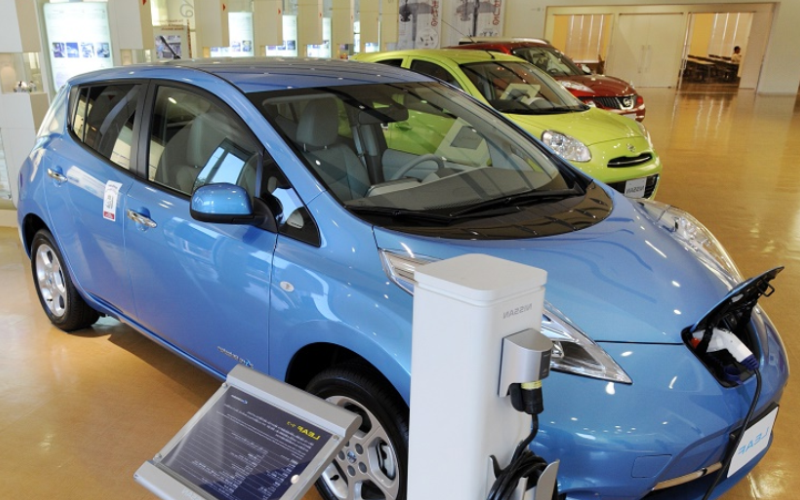In the US, federal government support for developing all-electric vehicles arguably dates back to as early as 1993 at the very end of President George Bush Sr’s term in office. One of the final acts of the administration was the setting up of the Partnership for a New Generation of Vehicles (PNGV). The task of this partnership was to bring together the government and its laboratories and several of the then biggest automakers — DaimlerChrysler, Ford and General Motors (GM) — to deliver a passenger car capable of 80mpg to the mass market by 2003.
Ultimate, the PNGV was abandoned in 2001, with none of the five concept vehicles suggested by three auto companies ever making it to production. At the same time, however, two Japanese companies who had been excluded from the partnership, Toyota and Honda, delivered the world’s first hybrid electric vehicles (HEVs) to the market in the form of the Toyota Prius (2000) and the Honda Insight (1999). The Prius had been available in Japan since 1997.
This example seemed to show that government support for EVs was not the best way to bring EVs to the marketplace. Others continue to contend that the only way for the electric car market to have any meaningful impact on the world is for it to be massively supported by government policy. In today’s blog, we’re exploring the relationship between governments and electric cars.
US Government Policy in 2020 and Beyond
The first foray of the US government intervention in the 1990s didn’t go to well, and the concept was somewhat humiliated by two non-US companies who did what the mighty consortiums of the US and their government backers could not. Honda and Toyota’s achievement was also done after having been expressly rejected from taking part in PNGV in the first place.
President Obama
On July 21, 2016, the White House issued a press release announcing that the Obama administration was announcing both “federal and private sector actions to accelerate electric vehicle adoption in the United States.” The context of the announcement was the administration’s plan to “take responsible steps to combat climate change.”
Obama’s announcement included the following measures:
- Up to $4.5 billion in loan guarantees to support commercial-scale charging facility innovation and its rapid deployment across the country.
- The “FAST Act” process, which looked for zero emission fuel corridors that would lay down the framework for a national network of well-placed charging infrastructure by 2020.
- A call for state, county and local governments to work with federal agencies to acquire fleets of discounted electric vehicles to use.
- Getting companies, non-profit organizations and utilities to sign up for the Department of Energy’s Workplace Charging Challenge where they would commit to providing charging stations for their workforce to use.
In reality, it was really just a call to action for more companies to commit to the idea of making electric vehicle charging infrastructure a more meaningful and lasting part of their overall development plans.
President Trump
Trump’s overall policy was overwhelmingly pro-carbon, which saw his administration end a bipartisan deal that was designed to extend a tax credit for those buying EVs, as well as repealing of car pollution rules. At the same time, Trump waged a trade war against China that was extremely detrimental to the auto industry who relied on access to the lucrative Chinese market.
All of that is what people are aware of, but there is actually a little more to it than that. Arguably the most interesting result of Trump’s administration when it comes to electric vehicles, as pointed out by The Atlantic, is that he broke the age-old partnership between auto companies and oil companies.
For decades prior to Trump’s presidency, the oil companies of Houston, Texas and the car companies of Detroit, Michigan, maintained a firm alliance. The car companies produced the big machines that everybody wanted and needed, and the oil companies supplied the fuel and engine oil to run them. The less efficient the cars and less reliable the cars were in the long term, the more the partnership would prosper. We’ve perhaps all heard of that paradigm.
From 2016, however, a new dynamic was developing. As Trump repealed the above-mentioned car pollution laws, the oil companies celebrated but, to everyone else’s surprise, the car companies refused to support it. In the years of Trump’s presidency, the commitment to developing hybrid and electric variants of existing models seemed to grow in spite of the oil companies’ efforts to make it easier to once again go back to gas guzzlers.
Towards the end of Trump’s administration, there emerged a new and powerful lobbying force that was working to further the interests of electric vehicles – ZETA (Zero Emission Transportation Association). Founder of ZETA, Joseph Britton was quoted in The Atlantic as saying, “Our goal is to change politics so that every new vehicle sold by 2030 is an EV.”
This sentiment aligned well with what other overseas governments and a number of state legislatures in the US was already working toward, but more on that further down.
President Biden
And now we come to the incumbent. It didn’t take Joe Biden long to confirm his dedication to a vision of an electrified American automotive industry, not dissimilar to the viewpoint espoused by ZETA. As reported by CNBC, it only took a single day after being confirmed by the Electoral College for Joe Biden to voice his huge support for government moves to support EVs.
One thing he promised was $400 billion in public investment to provide clean energy. A big part of that is battery technologies and EVs. The plan includes support for 500,000 new EV charging outlets to be made available by the end of 2030. That’s a big ask considering that at the time of then-President-Elect Biden saying that, the US Department of Energy’s figures showed that the US only housed 29,000 charging points.
US Federal Tax Credit
Through multiple presidencies, the federal government has been offering (and still does) up to $7,500 in tax credits to anyone purchasing an all-electric car. The idea is that given the relatively high expense of electric cars, the tax credits would help to offset the cost and artificially make electric vehicles more competitive.
Even with that support, people have not adopted EVs probably as fast as the creators of the tax credit had first hoped when Obama first announced the credit back in 2011 as part of an ambition to make America the first country to have 1 million EVs on the road by 2015. That milestone wasn’t achieved until September 2018, when the Edison Electric Institute hosted an event to celebrate it at the end of November 2018.
Data from 2020 shows that the United States had a little over 1.7 million cumulative sales of plug-in electric vehicles on the road, accounting for just 1.9 percent of total market share, and annual sales of 297,939 units in 2020. China, on the other hand had reached market share of 5.4 percent, and the European union 11.4 percent. Outside of the EU, Norway has been the runaway success, with a market share for EVs in 2020 of 74.7 percent in total.
So, did federal tax credits work? They don’t seem to have had a massive effect in the US, but member states of the European Union, as well as non-member states like the UK have all employed similar incentives and achieved greater market share. China’s government is also heavily intervening to subsidize companies like BYD, Xpeng and others to create EVs that can rival American companies like Tesla.
Regulatory Credits
In order to comply with increasingly stringent emissions standards around the world, automakers are having to cut their overall emissions levels among their ranges. The fastest way to do this, of course, is to replace internal combustion-engine cars with electric models. Cutting their emissions is one way to reach the requirements, but so too is acquiring regulatory credits, also known simply as “green credits.”
Tesla makes a huge amount of money — $428 million in the second quarter of 2020 alone, according to caranddriver.com — by selling its surplus of green credits to other automakers. It’s a happy arrangement, allowing Tesla to continue posting profits even during one of the worst economic downturns in history. Meanwhile, the other automakers avoid the steep fines and other measures that can be levelled against them for failure to comply.
You could say that this is incentivizing the development of electric vehicles by force. Starting with rules made in 2009 and then enforced from 2012 by the Environmental Protection Agency (EPA), automakers agreed to make their ranges’ average CO2 emissions just 163g/mile, which is the equivalent to a fleet average of 54.5mpg. by 2025. They have to work towards this goal year on year, proving their progress.
The main result of this system seems to have been generating a lucrative, even decisive, profit center for Tesla, while forcing other automakers to purchase green credits just to keep up. Starting in 2018, each year brought many new announcements and releases of new all-electric models of existing model designs. Even after everything, perhaps the end is starting to justify the means.
EV Incentives Worldwide
Here is a sample of what some of the other major automotive markets around the world have been doing to incentivize the sale of EVs and the development of EV as a thriving sector of the automotive industry.
China:
Starting in 2010, China offered incentives of up to $9,281 to help people make private purchases of electric vehicles, which China refers to as “New Energy Vehicles” (NEVs). They also offered $7,634 for those looking to buy plug-in hybrid vehicles. These sums were paid directly to automakers as a way to get them to directly reduce prices when selling to consumers.
China’s subsidy program ran into difficulty in 2011 when it was discovered that rather than making use of the government subsidy, consumers were just purchasing smaller low-speed EVs that only cost $4,800 to buy outright. They didn’t even need driving licenses to operate them because the vehicles’ top speed was less than 50km/h (31mph).
The government addressed this by introducing a credit system quite similar to the US “Green Credits” that are issued to automakers for producing electric vehicles. They ordered that car companies selling more than 30,000 units a year had to maintain 8 percent of their sales as EVs. That was in 2018, and it was subsequently increased to 12 percent by 2020.
Norway:
Norway seemed to get the incentives program right. They initially promised some impressive incentives, including:
- Exemption from any an all non-recurring vehicle fees, including VAT
- Free parking
- Permitted use of bus-only lanes
- Exemption of VAT on EV leases (from 2013)
The government managed the incentives by issuing a limited number of special number plates with the format EL 99999. There were 50,000 plates produced with the goal of getting 50,000 EVs on the roads by 2018. They achieved the 50,000-unit milestone in 2015, and continued with the scheme until 2016. While many of the benefits were eventually phased out by 2017, some small things remain like some of the free parking.
Canada
Canada’s federal government introduced an incentive program starting in May 2019. It allows for a CA$5,000 rebate ($3960) on the post-tax cost of any eligible new EV or hydrogen-powered vehicle. They also created a program of rebates for businesses and governments who installed EV charging stations in workplaces, public places and residential buildings.
United Kingdom
The UK instituted what they called the “Plug-in Car Grant” which started in the early days of Prime Minister David Cameron’s coalition administration back in 2011. It offered a 25 percent grant towards the cost of a new PEV, but it was capped at £5,000 ($6,963). The threshold was increased to 35 percent in 2015, which allowed cheaper electric cars to be subsidized at the same level as more expensive ones.
After 2016, the government published a list of 31 cars that were eligible (known as Category 1) and excluded some of the top-end models (known as Category 3) like the Tesla Roadster and Mercedes-Benz S500 Plug-in Hybrid. Right now, cars with a value over £60,000 ($83,500) are not eligible for the rebate scheme. This incentive also extended to commercial vans from 2012.
Other incentives to promote EV sales included exemption from central London’s infamous “congestion charge.” This charge started in 2003 and now stands at £15 ($21) per day when driving through central London between 07:00 and 22:00 on any day except Christmas Day. That’s a good saving for EV drivers.
The UK has also done a lot to promote new charging stations. There are now 9,300 charging locations across the UK, which now outnumber the 8,400 gas stations. Firms have been incentivized by government investments and loans designed to incentivize new construction of EV charging infrastructure.
Does the EV Sector Need Government Support?
From the US and other countries’ examples, we learn that there are mixed results from government intervention. Pro-interventionists argue that in the face of cheaper competition from gasoline- and diesel-fueled cars, EVs need a “leg up” to help them get established in the marketplace. The car companies and oil companies also have very powerful lobbying interests in Washington D.C., such as the Alliance for Automotive Innovation, which pro-EV interests do not necessarily have.
Anti-interventionists point out that the car companies have already voiced their support and demonstrated their support by not supporting President Trump’s proposed rollback of Obama-era policies on emissions standards. Therefore, EV interests don’t need government support because auto companies are backing them in droves already. Even luxury brands like Jaguar, Mercedes-Benz, Audi, and now Bentley are released electric or hybrid vehicles into their range. Bentley even promised to replace its entire range with electric vehicles by 2025.
While both sides have good points to make, it’s hard to say for sure if no government intervention at all would have allowed the EV market to get as far as it has done. Besides the incentives we described further above, the other perhaps more decisive factor is that an increasing number of world and regional governments are moving to ban the sale of new gasoline cars at some point between 2030 and 2040. Within the US, the states of New Jersey, New York, California, Washington, Colorado, Hawaii, Massachusetts, New Hampshire and the District of Columbia have all announced some level of measure to restrict or remove new gasoline car sales by at least 2050.
Such a ban would clearly have more of an impact on EV sales, especially in the US when combined with the EPA rules on emissions, which are supported by other global emissions standards like those of the European Union, for instance. To return to the main question of this section, are these bans needed? With them being implemented so early in the stages of the proliferation of mass-produced EV technology, that remains to be seen. Given that in 10 years, new gasoline cars in many countries will be a thing of the past, it’s now impossible for us to know for sure if or how fast the EV technology could have developed organically, experienced price reductions and become more widely adopted naturally by an increasingly eco-conscious younger generation of car buyers.
Government Support for EVs – Right or Wrong?
At the end of it all, what we seem to have is a question of means and ends. First of all, let’s deal with the “Right.”
Right:
There is a clear advantage to the local and wider environment of this kind of government action taken by administrations around the world. More zero-emission vehicles on the road mean fewer pollutants, cleaner air and a meaningful contribution to the “net-zero” goals of many governments with regard to their national carbon dioxide emissions. Given the urgent state of the global climate emergency, immediate and drastic action is justified.
At the same time, electric cars bring other advantages to consumers and to communities. They are cheaper to run as electricity per mile is a lot less costly than gasoline per mile, even with crude oil still languishing far below $100 a barrel as it is now. They are also quieter, helping to greatly reduce noise pollution in bigger cities.
Finally, with the goal of getting people to make the switch to electric cars as early as possible, it was essential that governments use financial incentives to make EVs more competitively priced when compared to regular gasoline cars. When choosing between a top-level trim Toyota Camry XSE at $30,420, and a base-level Nissan Leaf at $31,670, it seems a bit of a no-brainer, especially as the Toyota Camry is also efficient and reliable, and not a gas guzzler. With an incentive, the Leaf becomes cheaper than the Camry, and the consideration can continue.
Wrong:
On the other hand, there’s a lot to be said about governments acting rashly and in a heavy-handed way. There is a lot of speculation that many governments are motivated merely by international prestige and image to make the switch and subsidize electric cars, rather than from any genuine sense of duty to the environment or the planet. It’s possible that the environmental lobby doesn’t care about how the end is achieved or why, just so long as it is achieved.
China, for example, is clearly very motivated by trying to out-do the United States in this new industry. The United States has long held a lot of dominance in the traditional internal combustion car world. EVs are an opportunity for China to assert its own kind of authority and dominance.
When it comes to artificially lowering the cost of EVs, there are reasons to oppose such actions and even see them as foolish. History shows us that, inevitably, government subsidy just leads to higher prices lingering for longer. The only result is diminishing public funds and static — or even increasing — prices of goods. If you knew the federal government would fund $7,500 toward the cost, why would you lower your cost below $30,000? After the rebate, you remain competitive with the consumer, but your company secures $30,000 in payment rather than $22,500. You can’t blame companies for doing that kind of good business.
Meanwhile, having no financial incentive in place would create other kinds of incentives for automakers to find ways to innovate and make the EV core technologies cheaper to mass produce. Tesla boss, Elon Musk, at the company’s annual “Battery Day” event in September 2020, discussed the impending arrival of the 4680 batteries which will be cheaper and more efficient. If the general mood is switching toward electric, then let the companies compete to create the most cost-effective electric models.
This already has been seen historically and is continuing to happen with modern technologies. Personal computers used to cost thousands of dollars in the 1990s, but now you can pick up powerful computers for a few hundred dollars. There was no government incentive or intervention required to make that happen. The same goes for cell phones and now smartphones.
Conclusion: Good Intentions and Positive Endings
Overall, we’d say that when you take in to account all the factors, it’s probably just a good thing that we are making the switch to electric cars finally. Regardless of the incentives, there’s increasing competition in the EV field now which will naturally drive innovation and help to bring prices down. On top of that, governments around the world have been either ending or announcing the ends to their various schemes in the next few years.
Perhaps some of the measures have been overbearing and unnecessary, but the end result at least should be something positive for the US and for the wider global community. The years 2021 and 2022 are already promising some of the most exciting new EV releases, widening the scope and choice for consumers and once again improving on previous technology and electric range.



